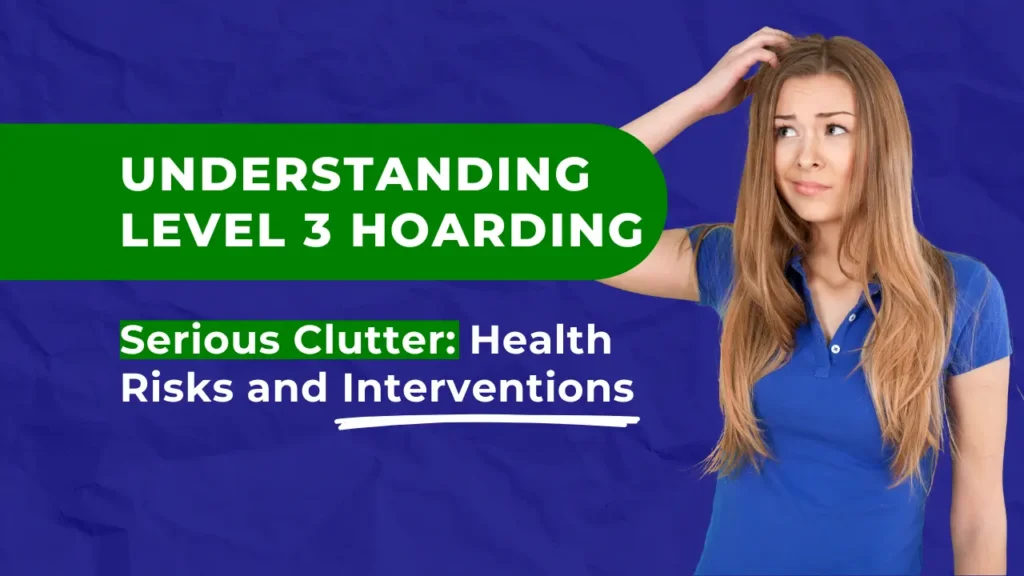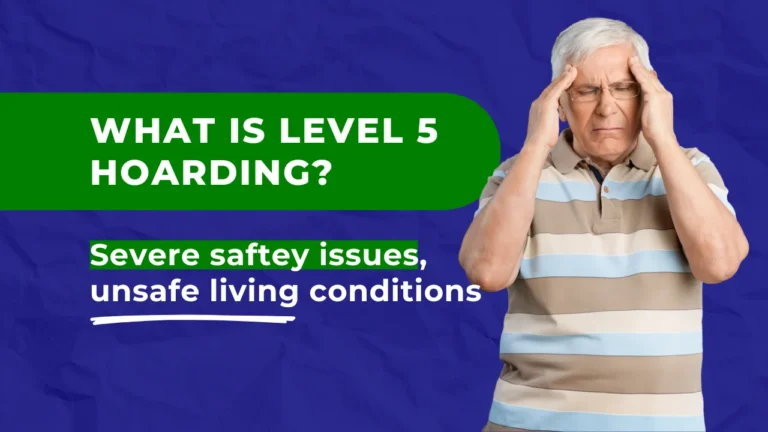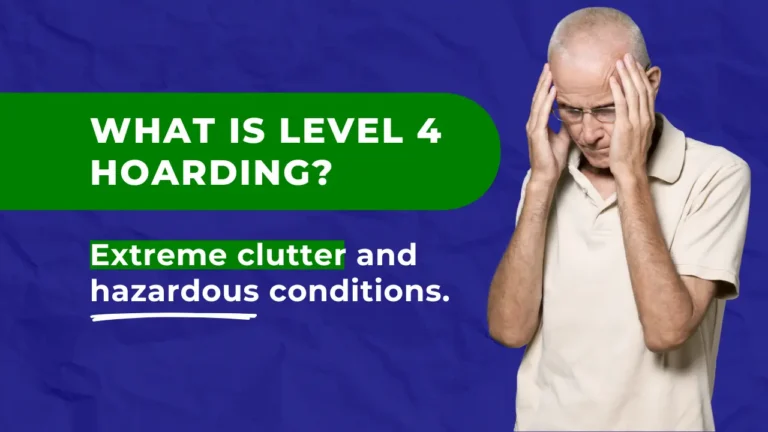Your elderly neighbour, Mrs. Johnson, has been living alone since her husband passed away last year. One weekend, when you realize that you haven’t seen her in a while, you decide to bring her a dish of casserole and check on her.
When she opens the door, you notice a strong odour emanating from the interior of the home and piles of items blocking the front hallway. As you step inside, you see stacks of newspapers, broken appliances, and old food containers covering most surfaces.
“Mrs. Johnson, how have you been?” you ask, trying not to wince at the overflowing cat litter box in the living room. She responds that she’s “been managing,” but one look (and one whiff) is all it takes to confirm that she’s far from okay.

This scenario is indicative of Level 3 hoarding, where clutter begins to severely impact daily living and even pose health and safety risks. In this blog, we explain the everything you need to know about this hoarding level- how it manifests itself, common behaviours, etc.- and what you can do to help an affected friend or family member.
Level 3 Hoarding Explained
Level 3 hoarding is a more severe category on the Clutter-Hoarding Scale, a tool developed by the Institute for Challenging Disorganization (ICD) to assess the severity of hoarding and clutter in a home. This scale helps professionals, family members, and individuals understand the level of hoarding and determine appropriate interventions. The scale is divided into five levels, each representing increasing degrees of clutter and associated risks.
There are multiple stages of hoarding but at the Level 3 stage, the clutter disrupts daily activities, and the home environment often becomes hazardous. Individuals at this level start to face severe challenges in maintaining a livable space, and the clutter begins to take over multiple areas of the home.
The clutter at Level 3 is not limited to piles of newspapers or clothes; it often includes broken appliances, old food containers, and garbage that hasn’t been taken out regularly. These conditions can lead to health risks such as mould growth and rodent and insect infestations. The home may also suffer structural damage due to the weight and pressure of the accumulated items.
What Does Level 3 Hoarding Look Like?
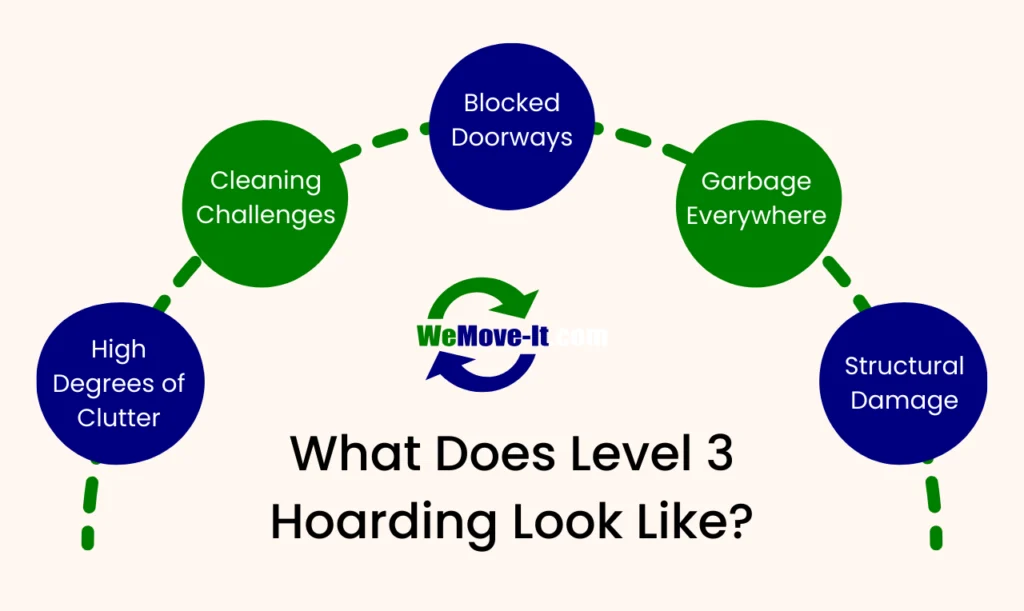
Level 3 hoarding is characterized by several specific symptoms and behaviours that impact daily living and the safety of the home environment.
- High Degrees of Clutter: Items cover most surfaces and block access to important areas of the home. Piles of newspapers, clothes, and other objects are often found in living rooms, kitchens, and bedrooms. These piles can reach several feet high and extend across the room, making it difficult to move around or use furniture.
- Cleaning Challenges: The amount of clutter makes cleaning nearly impossible. Dirt, dust, and grime accumulate, leading to unsanitary conditions. Without regular cleaning, the home can quickly become a breeding ground for bacteria and allergens, contributing to health problems such as respiratory issues and skin irritations. In the kitchen, expired food and unwashed dishes can attract pests, while the bathroom may have mould and mildew, making it a health hazard.
- Blocked Doorways: Multiple exits may be blocked by piles of items. This can prevent quick evacuation during fires, natural disasters, or other emergencies, increasing the risk of injury or death.
- Garbage Everywhere: Garbage and food waste accumulate in various parts of the home, attracting pests like cockroaches, ants, and rodents. Overflowing trash bins and scattered garbage can contribute to a pervasive, unpleasant smell and make it hard to walk through the home.
- Structural Damage: The weight of the clutter can lead to structural damage in the home. Floors may sag under the weight of heavy piles and walls may develop cracks or mould. This damage can compromise the safety and stability of the home, leading to costly repairs or even making it uninhabitable.
Individuals at this hoarding stage limit visitors due to embarrassment and fear of judgment, leading to social withdrawal. As they lose contact with their support networks, mental health issues, such as depression and anxiety, can worsen.
Common Behaviours Associated With Level 3 Hoarding
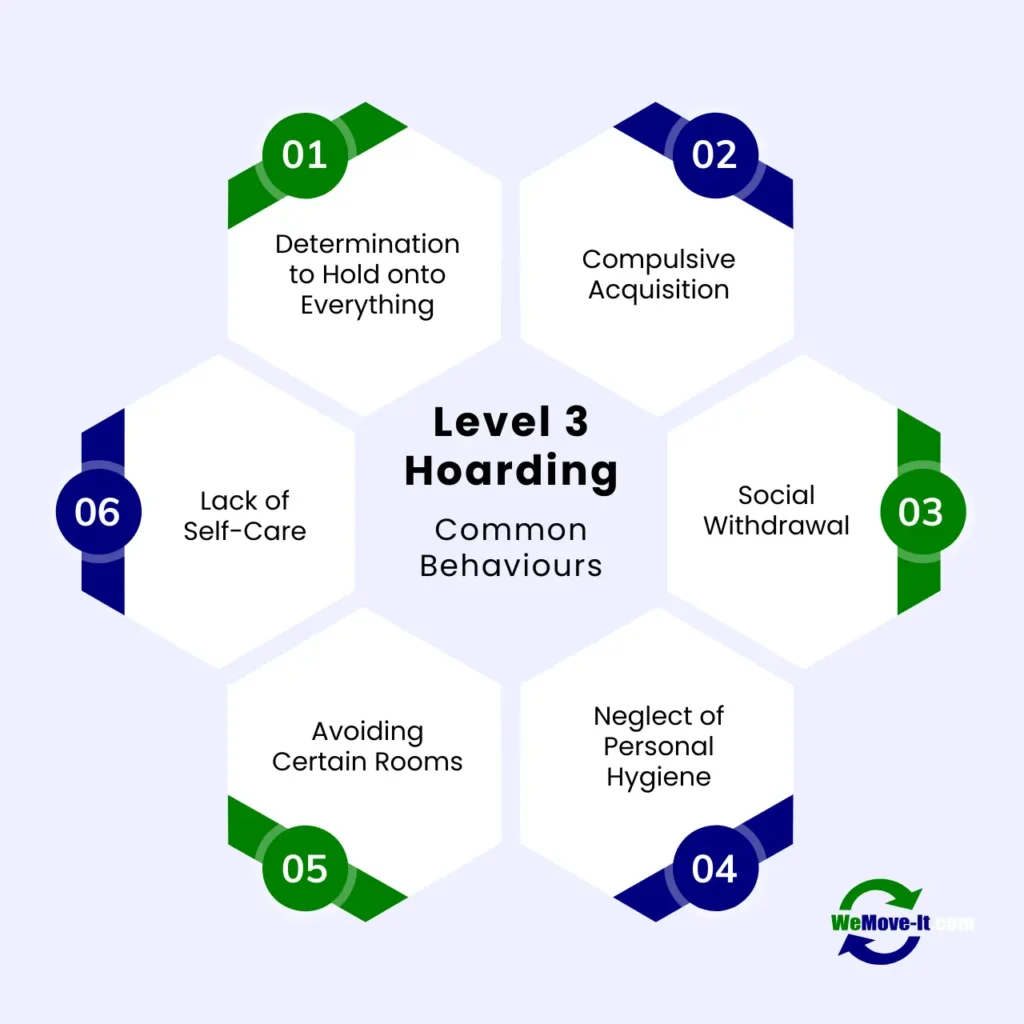
Level 3 hoarding is marked by behaviours that impact the individual’s daily life and interactions with others. They include but are not limited to:
- Determination to Hold Onto Everything: Hoarders at this level find it extremely difficult to let go of possessions, regardless of their value or usefulness. This behaviour is often driven by a strong emotional attachment to items, a fear of needing them in the future, or a sense of security they provide. The thought of discarding items can cause significant anxiety and distress.
- Compulsive Acquisition: Individuals with Level 3 hoarding often continue to acquire items even when their home is already overcrowded. This can include buying new items, picking up free ones, or refusing to discard things they already have. The accumulation of possessions can quickly outpace any efforts to manage the clutter.
- Avoiding Certain Rooms: To reduce stress, Level 3 hoarders may avoid parts of their home that are especially cluttered. This avoidance can lead to the neglect of entire rooms, which become unusable and increasingly dirty over time. As a result, the functional living space within the home becomes severely limited.
- Social Withdrawal: Due to embarrassment and fear of judgment, individuals with Level 3 hoarding tend to isolate themselves. They may stop inviting friends and family over and avoid social interactions that could lead to others discovering their living conditions. This isolation can worsen mental health issues, such as depression and anxiety.
- Neglect of Personal Hygiene and Self-Care: As the clutter consumes more of their time and space, hoarders may neglect their personal hygiene and self-care. This neglect can lead to health problems and a further decline in quality of life.
These behaviours create a challenging environment for hoarders and those around them. Recognizing these patterns is the first step towards seeking help and improving their living conditions.
How Can You Support a Level 3 Hoarder?
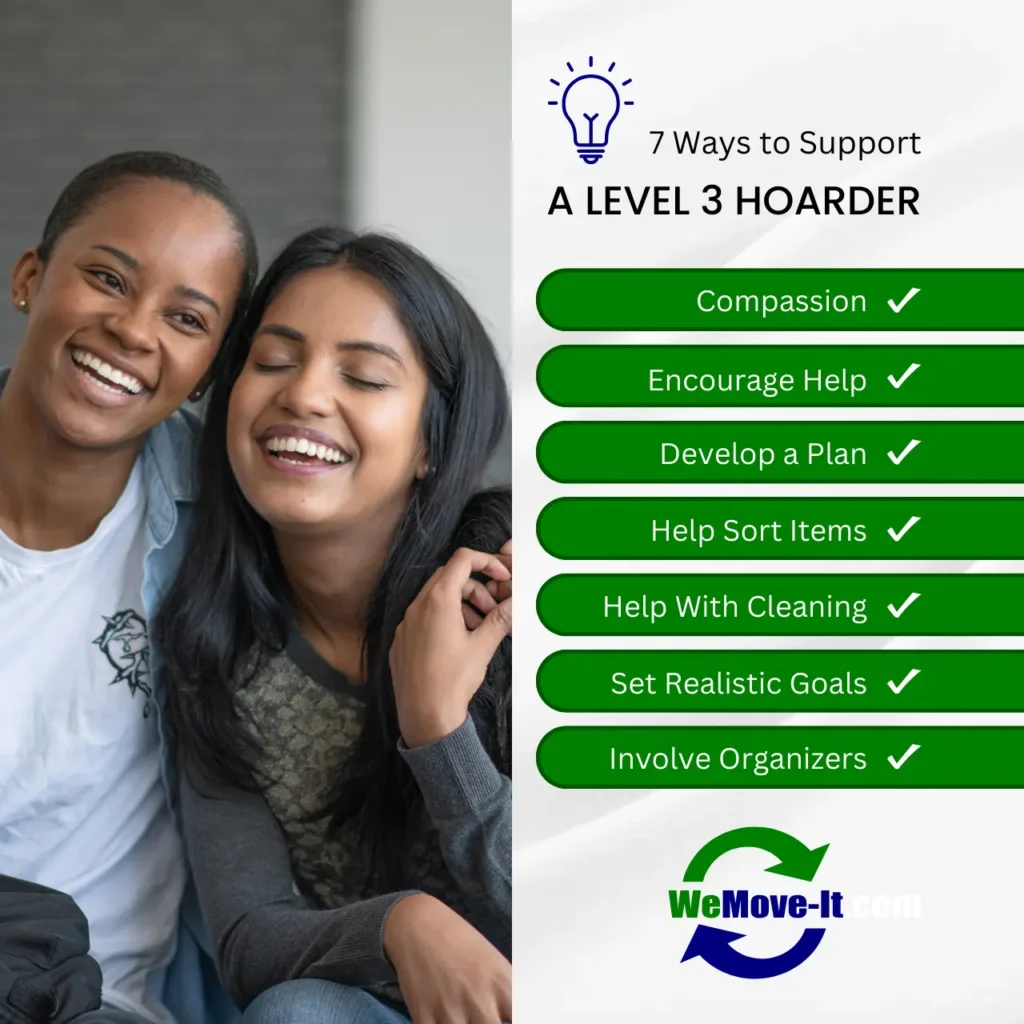
Helping a Level 3 hoarder requires patience, understanding, and a practical approach. Here are some steps you can take to provide meaningful support.
- Start with Compassion: Approach the hoarder with empathy and without judgment. Understand that their behaviour is often linked to deeper emotional and psychological issues. Show that you are there to help, not to criticize.
- Encourage Professional Help: Suggest that they seek assistance from mental health professionals, such as therapists or counsellors. Cognitive-behavioural therapy (CBT) is one effective method for treating hoarding disorder. If they are hesitant, offer to help them find a suitable professional or accompany them to appointments for support.
- Develop a Plan: Work together to create a step-by-step plan for addressing the clutter. This plan should include small, manageable tasks that can be accomplished one at a time. Set realistic timelines and be flexible, allowing for adjustments as needed.
- Help Sort Items: Help the hoarder sort their belongings into categories, such as keep, donate, and discard. This can be a slow process, but it is important to respect their feelings while gently encouraging them to let go of unnecessary possessions.
- Help With Cleaning: Offer to help with cleaning and organizing. This can include carrying out garbage, moving items, and deep cleaning areas that have been neglected. Be prepared for this to be a time-consuming and intensive effort. Wear protective gear, such as gloves and masks, if necessary, to ensure your safety during the cleanup.
- Set Realistic Goals: Establish realistic and achievable goals for each session of decluttering, and celebrate small victories to keep the hoarder motivated. Progress might be slow, but each step forward is important.
- Involve Professional Organizers: Consider hiring professional organizers who have experience dealing with hoarding situations. They can provide expertise and hands-on help to create functional systems for managing belongings. Professional organizers can also offer impartial advice and help maintain focus during the decluttering process.
Understand that progress can be slow and setbacks may occur. Stay patient and persistent, offering your help consistently without becoming frustrated. Encourage the hoarder to take breaks when needed and to not be discouraged by temporary setbacks.
Need Help with Level 3 Hoarding Cleanup?
While relatively severe, Level 3 hoarding can still be managed with the right support and intervention. At WeMove-It.com, we offer hoarder cleanup services 24-7: this includes deep cleaning, removal of garbage and unwanted items, and even restoration. From beginning to end, we make sure you and your loved ones (and even elderly neighbours like Mrs. Johnson) feel understood and supported.
Interested in exploring other hoarding levels? Check out our posts on hoarding level 1 and hoarding level 2 as well.
Don’t let clutter and hoarding behaviours take control of your health and future. Our hoarding cleanup specialists are ready to help you reclaim your home and improve your quality of life. For more information or to schedule a free estimate, call (844) 866-8348 today.
